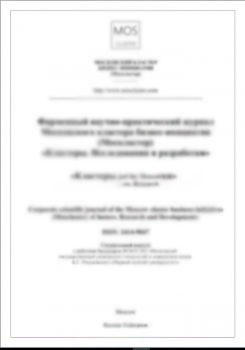, Россия
Москва, г. Москва и Московская область, Россия
ГРНТИ 50.07 Теоретические основы вычислительной техники
ББК 3297 Вычислительная техника
The article is devoted to the creation of a surface radiance factor mathematical model. The basis of the model is the solution of the boundary value problem of the radiative transfer equation (RTE). The surface is considered as a structure consisting of several turbid layers, each of which is characterized by its optical parameters. The top of the structure is randomly rough, uncorrelated, Fresnel. The lower boundary reflects perfectly diffusely. The complexity of solving the RTE boundary value problem for real layers is due to the fact that the suspended particles in each layer are always much longer than the wavelength. This leads to a strong anisotropy of the radiance angular distribution according to Mie theory. The solution comes down to a system of equations by the discrete ordinates method that consists of several hundred of differential equations. Subtraction of the anisotropic part from the solution based on an approximate analytical solution of the RTE allows avoiding this problem. The approximation is based on a slight decrease in the anisotropic part of the angular spectrum. The matrix-operator method determines the general solution for a complex multilayer structure. The calculation speed can be increased without compromising the accuracy of the solution with the help of the synthetic iterations method. The method consists of two stages: the first one repeats the described one with a small number of ordinates; on the second one the iteration of it is performed. The model is realised in the Matlab software.
radiative transfer equation, matrix-operator method, synthetic iterations method
1. Adams M.L., Larsen E.W. Fast iterative methods for discrete-ordinates particle transport calculations // Progressin Nuclear Energy, 2002. Vol.40, No.1. P.3-159.
2. Budak V.P., Klyuykov D.A., Korkin S.V. Convergenceacceleration of radiative transfer equation solution atstrongly anisotropic scattering // In Light Scattering Reviews 5. Single Light Scattering and Radiative Transfer /Ed. A.A. Kokhanovsky. Springer Praxis Books, 2010.P.147-204.
3. Budak V.P., Korkin S.V. On the solution of a vectorialradiative transfer equation in an arbitrary threedimensional turbid medium with anisotropic scattering //J. Quant. Spectrosc. Radial. Transfer., 2008. Vol. 109. P.220–234.
4. Budak V.P., Veklenko B.A. Boson peak, flickering noise,backscattering processes and radiative transfer in randommedia // J. Quant. Spectrosc. Radial. Transfer., 2011. Vol.112. P.864-875.
5. Flatau P.J., Stephens G.L. On the Fundamental Solutionof the Radiative Transfer Equation // JGR, 1988. V.93,No.D9. P.11,037-11,050.
6. Fryer G.J., Frazer L.N. Seismic waves in stratified anisotropic media // Geophys. J. R. Astr. Soc., 1984. V.78,P.691-698.
7. Karp A.H., Greenstadt J., Fillmore J.A. Radiative transferthrough an arbitrarily thick, scattering atmosphere // J.Quant. Spectrosc. Radial. Transfer., 1980. Vol. 24. P.391-406.
8. Kokhanovsky A.A. et al. Benchmark results in vector atmospheric radiative transfer // J. Quant. Spectrosc. Radial. Transfer., 2010. Vol.111. P.1931-1946.
9. Milne E.A. The reflection effect of the eclipse binaries //Mon. Not. Roy. Astrophys. Soc., 1926. Vol. LXXXVII.P.43-49.
10. Plass G.N., Kattawar G.W., Catchings F.E. Matrix Operator Theory of Radiative Transfer // Appl. Opt., 1973.Vol.12. P.314-326.
11. Redheffer R.M. Inequalities for a matrix Riccati Equation// Journal of Math. and Mechanics, 1959. V.8. P.349–367
12. Tanaka M., Nakajima T. Effects of oceanic turbidity andindex refraction of hydrosols on the flux of solar radiationin the atmosphere-ocean system // J. Quant. Spectrosc.Radial. Transfer., 1977. Vol.18, No1. P.93-111
13. Ambartsumian V.A. K zadache o diffuznom otrazheniisveta To the problem of diffuse reflection of light. //JETF, 1943. Vol. 132, No. 9-10, P.323-334 (in Russian).
14. Basov A.Yu., Budak V.P. Model' rasseivayushchegosloya s diffuznoj podlozhkoj i frenelevskoj granicej Model of a scattering layer with a diffuse bottom and aFresnel boundary. // GraphiCon 2018. Conference proceedings. Tomsk, Russia. P. 399-401 (in Russian).
15. Krylov V.I. Priblizhennoe vychislenie integralov Approximate calculation of integrals. // Nauka Publ., Moscow, 1967 (in Russian).





